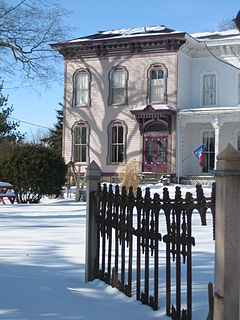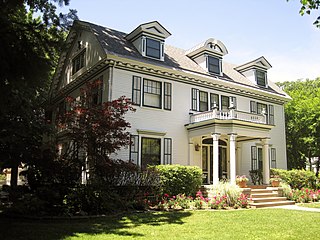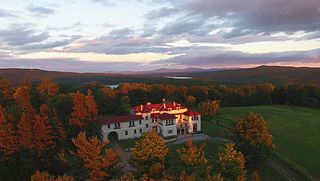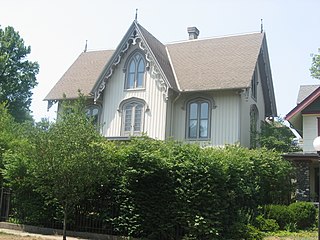Washburn Guitars is an American manufacturer and importer of guitars, mandolins, and other string instruments. The original company was established in 1883 in Chicago, Illinois. Today, Washburn is a brand of U.S. Music Corp., a subsidiary of Canadian corporate group Exertis | JAM.

Bassett Hall is an 18th-century farmhouse located in Williamsburg, Virginia. It was the home of John D. Rockefeller, Jr. and his wife Abby Aldrich Rockefeller during the restoration of Colonial Williamsburg.
Roscoe Harold Zook was an American architect best known for his work in suburban Chicago, Illinois. He received a degree in architecture from the Armour Institute of Technology in 1914. In 1916 Zook married his first wife, Mildred Barnard. They divorced in the late 1930s. They had one son, Harold Barnard Zook, who followed in his father's footsteps to become an architect in Corona del Mar, California. In the early 1940s, Zook married his second wife, Florence (Barkey) Nissen, whom he met through mutual friends. Zook died in April 1949, just short of his 60th birthday.

The Sarasota Times Building is a historic site in Sarasota, Florida. It is located at 1214–1216 1st Street. On March 22, 1984, it was added to the U.S. National Register of Historic Places. The three-story asymmetrically-massed, stucco and cast stone façade, Mediterranean Revival structure was designed by architect Dwight James Baum. It is significant to Sarasota's heritage for its role as a newspaper established in 1899, and also for its architectural merits.

The houses in the Sycamore Historic District, in Sycamore, Illinois, United States, cross a variety of architectural styles and span from the 1830s to the early 20th century. There are 187 contributing properties within the historic district, 75% of the districts buildings. Many of the homes are associated with early Sycamore residents, usually prominent business leaders or politicians. Houses within the district are known by, either their street address or by a name associated with a prominent owner or builder. For most of the houses, the latter is true.

The Washburn-Fair Oaks Mansion District is a historic district in the Whittier neighborhood of Minneapolis, Minnesota, United States, centered on Washburn-Fair Oaks Park. The city of Minneapolis designated a district bordered by Franklin Avenue, Fourth Avenue South, 26th Street East, and First Avenue South. A smaller district, listed on the National Register of Historic Places, includes seven mansions along and near 22nd Street East.

The Montford Area Historic District is a mainly residential neighborhood in Asheville, North Carolina that is included in the National Register of Historic Places.

Sennett and Bertha Kirk House is a 1913 Colonial Revival house in Garnett, Kansas, United States. The house was listed on the National Register of Historic Places (NRHP) in 2005. In 2017, the house is operated as The Kirk House, a bed and breakfast.
Bassett House may refer to:

The Glen Ellyn Main Street Historic District is a set of eleven buildings in Glen Ellyn, Illinois. The houses were built between 1874 and 1890 when the village was known as Prospect Park. The swampy setting of the village began to gain a reputation as a retreat away from the city, and by 1882 the village was large enough for incorporation. Wealthy businessmen built homes along the main stretch of the village in what would become the historical district. In the mid-1880s, a river was dammed, creating Lake Glen Ellyn, spurring the new name for the village.

The Robert A. and Mary Childs House is a historic Queen Anne Style residence in Hinsdale, Illinois originally owned by Robert A. Childs.

The Downtown Hinsdale Historic District is a set of seventy-three buildings and one park in Hinsdale, Illinois.

The Robbins Park Historic District is a set of three hundred and sixty-eight buildings in Hinsdale, Illinois. Two hundred and thirty-two of these builds contribute to its historical value. The district was platted by William Robbins in the 1860s and 1870s following the completion of the Chicago, Burlington and Quincy Railroad. Wealthy entrepreneurs moved to the district beginning in the 1890s due to its natural beauty and proximity to major golf resorts. The district was added to the National Register of Historic Places in 2008 and features two houses previously honored by the register.

The Mission Revival style was an architectural movement that began in the late 19th century for a colonial style's revivalism and reinterpretation, which drew inspiration from the late 18th and early 19th century Spanish missions in California. It is sometimes termed California Mission Revival, particularly when used elsewhere, such as in New Mexico and Texas which have their own unique regional architectural styles.

The Riverview Historic District is a historic district in Kankakee, Illinois, United States. The 78.2-acre (31.6 ha) area around the Kankakee River is the oldest intact residential neighborhood in the city. It was originally settled by Emory Cobb, who used the land as pasture before deciding to erect a resort hotel. After the hotel burned down, the property was subdivided. The district includes 118 contributing buildings, including two Frank Lloyd Wright houses.

Orland P. Bassett was an American floriculturist who is known for popularizing the American Beauty rose with Bassett & Washburn. He also was the longtime owner of the Pictorial Printing Company.

Aldworth Manor, also known as the Arthur E. Childs House, is a historic summer estate house in rural Harrisville, New Hampshire. The house is located at the top of a hill at the end of Aldworth Road, formerly the estate's access drive, and was one of the premiere estate houses of the early 20th century in the town. The house was originally built c.1850 in Worcester, Massachusetts. It was inherited by Arthur E. Childs, a Worcester native from a wealthy family, in the early 20th century.

Emily Elizabeth Holman, better known by her professional name of E. E. Holman, was one of the first female architects of Pennsylvania. She was active from the 1880s to her retirement in 1914 and was responsible for planning several important historical sites like the Goold House in the Wilder Village Historic District, Wilder, Vermont and the National Park Seminary among many others.

The Horatio Chapin House, or simply, the Chapin House, is a historic home located at South Bend, St. Joseph County, Indiana. It was built between 1855 and 1857 by Horatio Chapin, one of the early settlers of South Bend and the first president of the board of town trustees. The house consists of a 2+1⁄2-story, cross-plan, Gothic Revival style frame dwelling, a rare example of its kind in the region. It's considered an outstanding example of Gothic Revival architecture influenced by architect Andrew Jackson Downing. It is sheathed in board and batten siding and features lancet windows and a steeply pitched cross-gable roof with an elaborately carved bargeboard. The Chapin House is widely recognized as one of the most significant homes in the state of Indiana, and in 1980 it was listed on the National Register of Historic Places.


















